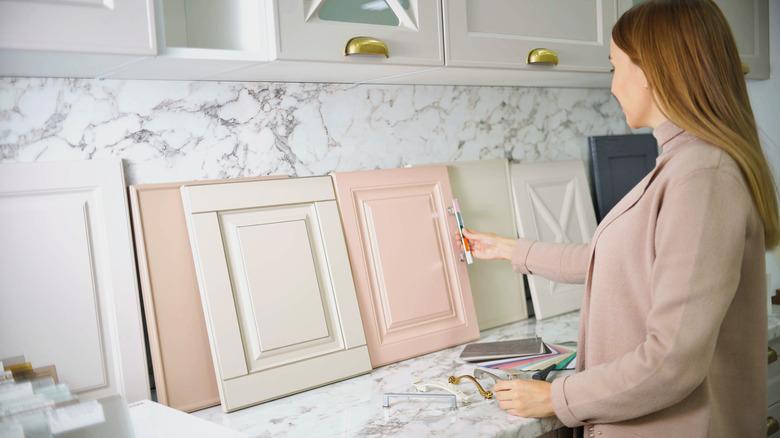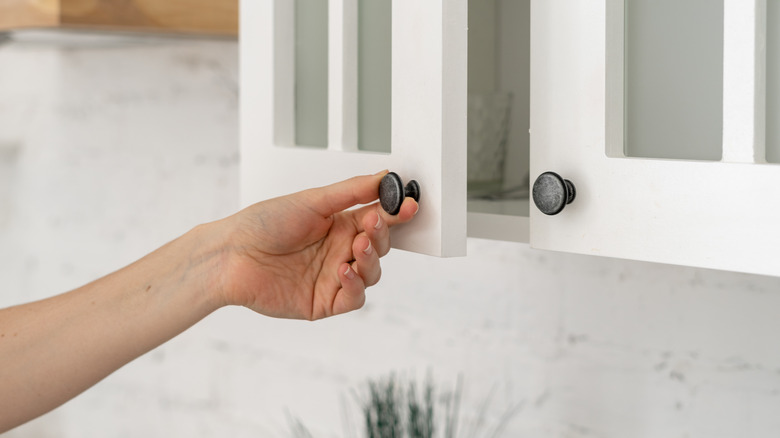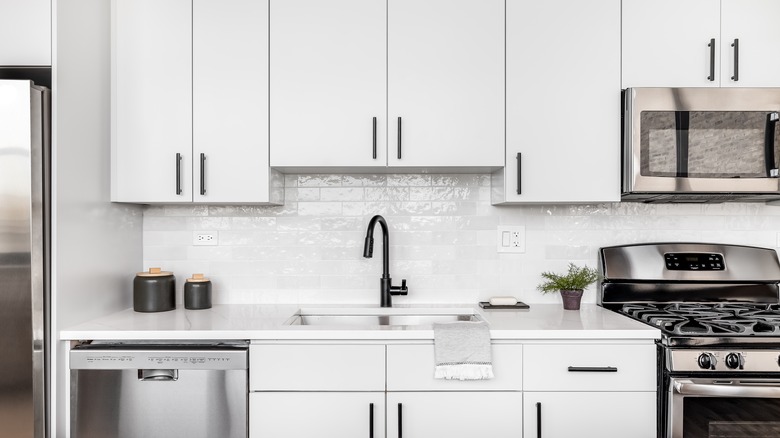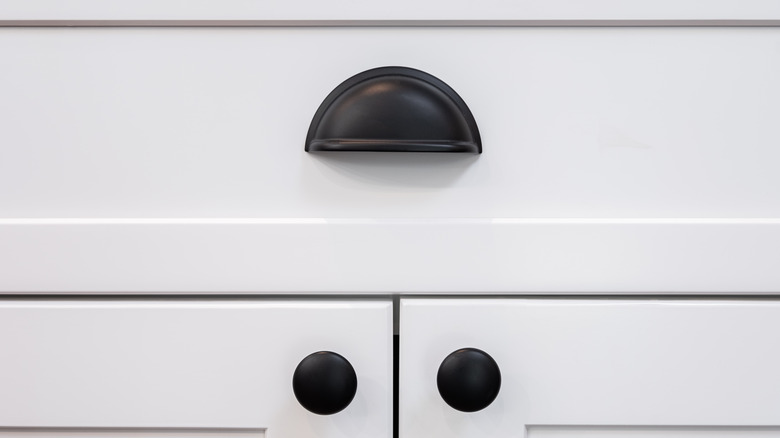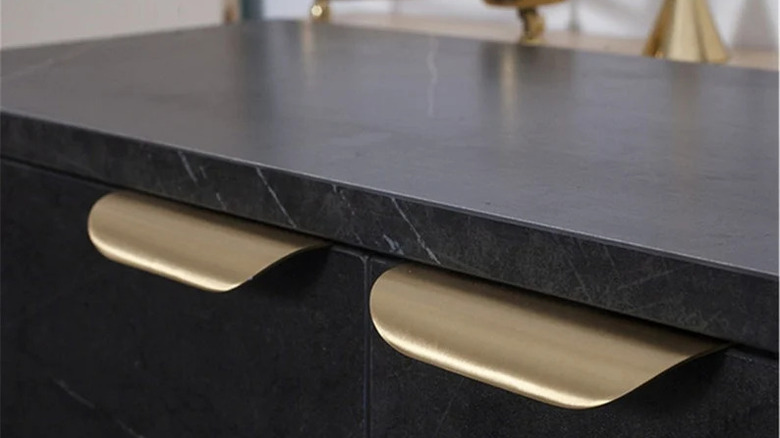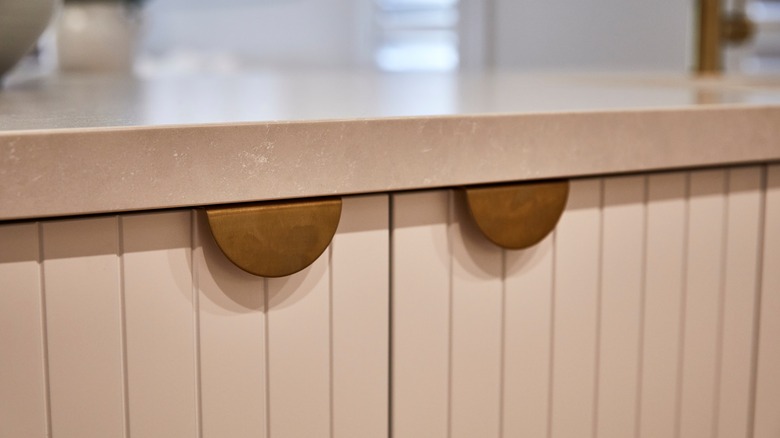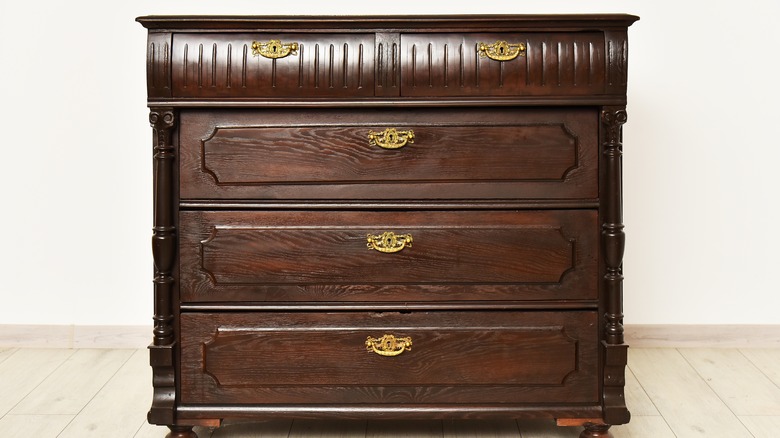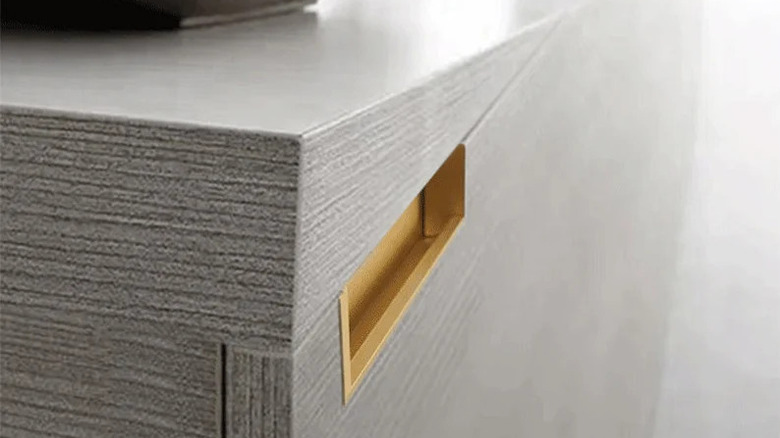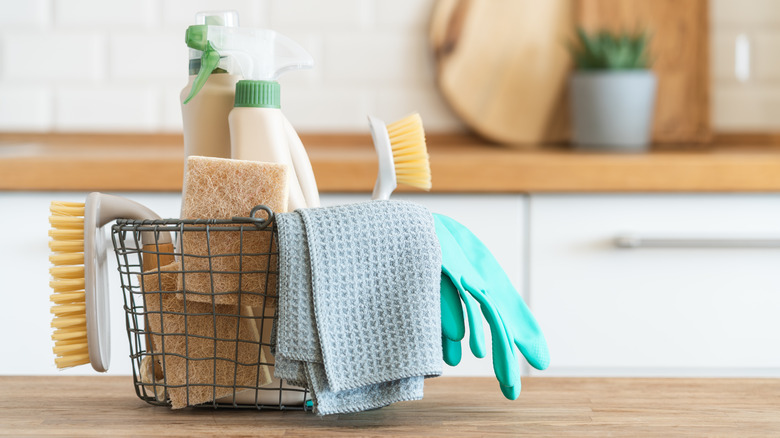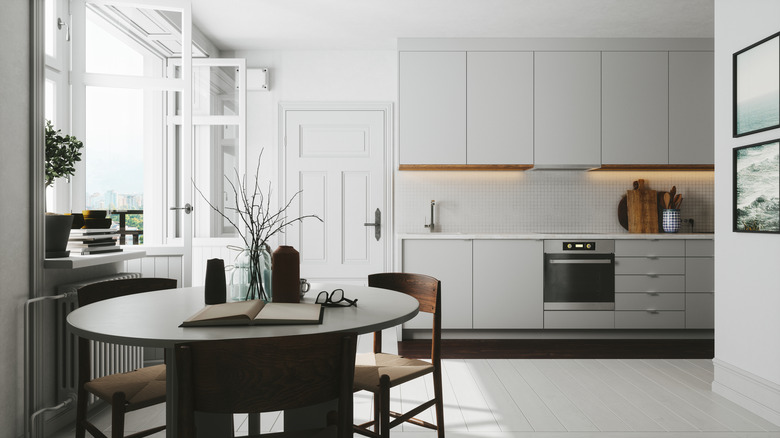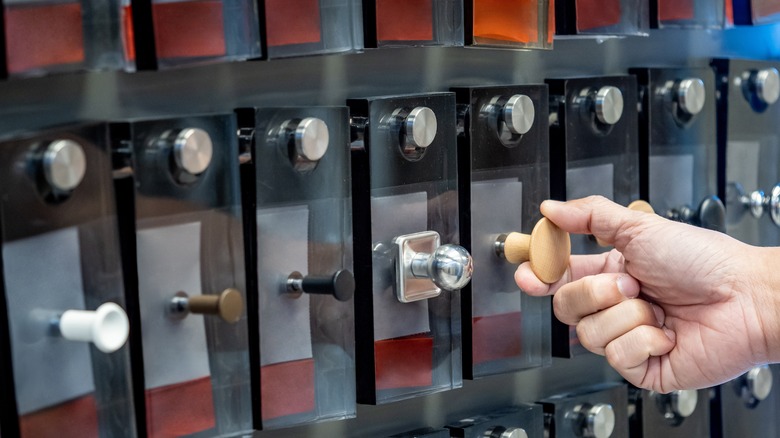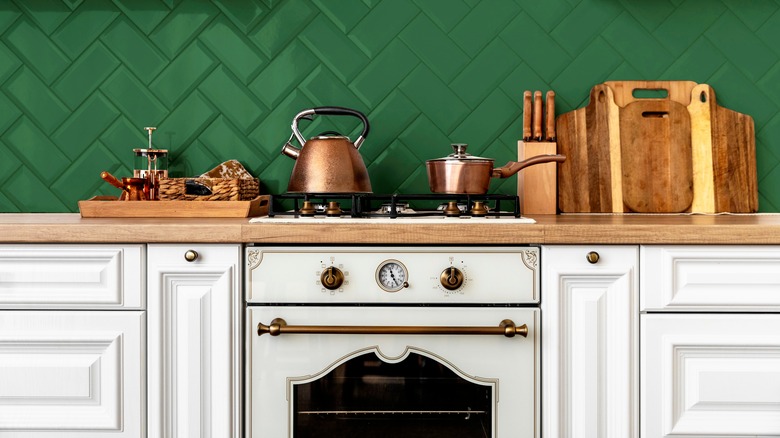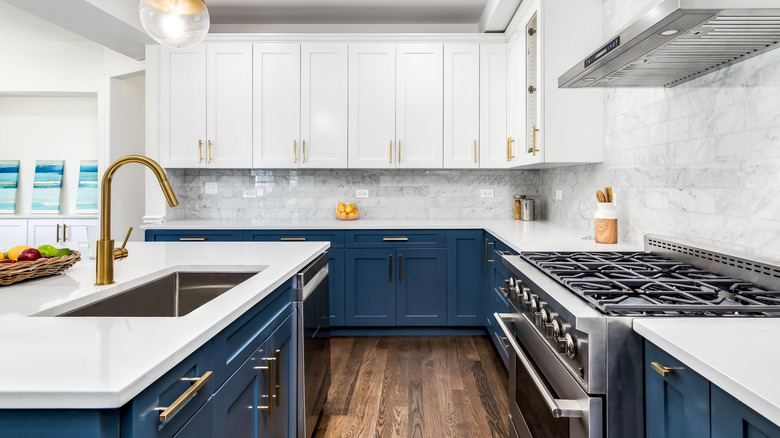Types Of Cabinet Hardware (And How To Choose What's Right For You)
We may receive a commission on purchases made from links.
Kitchens are one of the most complicated, disruptive, and expensive rooms to renovate. According to Bankrate, the average kitchen remodel budget is between $14,608 and $41,275. Besides costing some serious cash, kitchen renos also come with a boatload of decisions. What backsplash tile will go with your counters and flooring? Should you opt for shaker-style door fronts or slab doors? Two-toned cabinets, no uppers, or open shelving? The list can feel endless, and by the time you get to pick out cabinet hardware, it can be tempting to just grab the first option that catches your eye.
But here's the thing. A lot hinges on your hardware selection, from how functional your space feels to how cohesive the final result is. These little finishing details can make your design pop or drag it down. Cabinets will typically eat up around 30% of your kitchen renovation budget, so you want to pick hardware that's going to accentuate them. Your hardware also needs to meet your unique needs and be in keeping with the color palette and style of the space.
Designers often refer to cabinet hardware as the jewelry of kitchens. If you want your space to look seamlessly executed, you need to dedicate some serious thought to knobs and handles. Not sure where to start? Shelve that screwdriver and sit back for a full breakdown of all the different types of cabinet hardware, as well as some vital tips for making the right selection.
Knobs are small and nifty
Knobs are one of the mainstay types of cabinet hardware, and they come in a massive array of shapes, styles, and sizes. Although they're often used on small cabinet doors and drawers, there's no law that says you can't kit out your entire bank of cabinets with them. However, before you opt for an all-knob look, there are a few factors to consider.
They tend to be cheaper than pulls and simple to install, as you only need one screw. They're also easy to clean and have an approachable look. Depending on what effect you're after, this can be a good thing. But if you want to make a statement with your hardware, knobs might not have enough visual impact. When located on lower cabinets, they can also catch on clothing. With their single screw attachment points, they can come loose more easily than pulls, and on doors that butt together, you might find your fingers can get stuck between the adjacent knobs.
As far as which interior style knobs suit best, the answer depends very much on the individual shape and design you're using. Ornate, intricate knobs will almost always suit more traditional designs, while minimal styles can blend well with a range of interiors, including transitional and even modern spaces. However, compared to a lot of pulls, the majority of knobs do tend to have a more classic feel. If you're after a modern or contemporary aesthetic for your kitchen, look for sleek, clean shapes, angular options, and current profiles, such as T-knobs, square knobs, and geometric knobs.
Pulls offer greater performance for larger drawers and doors
The other overarching category of cabinet hardware is pulls. As with knobs, you can get your hands on pretty much any style of pull your heart desires, from ultra-angular and minimal to intricate, industrial, and everything in between. As for where to position pulls, you can place them on any cabinet or drawer front, do a mix of pulls and knobs, or opt for all pulls.
Pulls can command a higher price point than knobs, as they require more material. They also need two screws for mounting. But on a practical front, pulls offer a comfy place to grip and are often easier to grab for seniors and those who have arthritis. They also give you more leverage, which is great for heavy drawers laden with pots and tall cabinet doors. Unlike knobs, which only come in a certain size range (there's a limit to how big you can make a knob and still have it be functional), pulls also offer a lot more versatility. Depending on how big your door or drawer is, you can take your pick in pull size and opt for anything between 3 and 24 inches.
A lot of pulls these days have a modern look, but don't think you can't use them in traditional spaces. Ring and pendant pulls, swan neck pulls, and ceramic-handled varieties can all perfectly fit the bill. Most drop-handle pulls definitely fall into the traditional territory. Arch-shaped and bow kitchen handles often suit transitional designs, but their exact shape and level of detail also determine whether they will work in a modern or traditional space. On the whole, T-bar pulls, C-pulls, and very angular shapes are good bets for a modern aesthetic.
Cup pulls are a classic
Cup pulls are technically, well, pulls, but their specific shape and size make them almost like a blend between a knob and a handle. This popular pull dates back to Victorian times, and antique designs often feature intricate patterns and ornate elements. Traditionally, cup pulls appeared on apothecary chests as well as old-fashioned office drawers and bins, which is why they're also known as bin pulls.
One of the biggest benefits of cup pulls is they're great for not catching on clothing. Their rounded profile means no snagging and nothing for your hips (or a child's head) to bump into. If you've ever rammed your thigh into a T-bar pull, this could be a draw. As far as downsides go, bin pulls can be awkward to grip, particularly on drawers that are low to the ground. If you have very large hands, you may find it difficult to fit your fingers into the cup. They're only suited to drawers and won't work well on cabinet doors.
Even though cup pulls have a long history, they can work for a variety of design styles. Intricate, antique cup pulls could be perfect for a period kitchen. Less ornate, simpler designs lend themselves well to transitional styles and modern farmhouse design. They're also ideal for industrial spaces that have a touch of vintage. However, cup pulls can clash with modern, minimal design schemes. Unless you're looking to throw in a few touches from the past, bin pulls might not hit the mark.
Nothing as edgy as edge pulls
Mirror, mirror on the wall — who's the most modern pull of them all? If you're looking for an ultra-slick, uber-modern hardware option, edge pulls are it. Attached at the top of cabinets, these minimalist pulls align with the edges of doors and drawers, hence their name. This cuts down on visual busyness while still giving you something to grab onto. If you're a fan of the new, naked, no-hardware look, edge pulls offer a practical middle-ground solution. They won't interrupt the sleekness of your cabinets and drawers, but you also won't handle the corners with (potentially) oily, sticky, or flour-coated hands.
Another advantage of edge pulls is that they screw into the backs of cabinet doors and drawer fronts. This means no holes to mar the finish. If you ever want to move or swap out front-mounted hardware and need to fill holes, this can mean having to refinish all your kitchen cabinets. Edge pulls are also easy to clean, thanks to their linear design.
Speaking of design, edge pulls won't work for every interior. They pair poorly with traditional styles and will only fit if you're intentionally going for a transitional look. But if you're planning a modern, minimal kitchen, or something that's very current and organic, edge pulls could be the perfect finishing touch.
Half-moon handles offer an organic, modern look
Speaking of organic modern, if you're attracted to sparse, simple, yet warm and earthy spaces, half-moon handles are another option to consider. Like edge pulls, half-moon handles are a very current hardware style. As the name suggests, these trendy pulls feature half-round fronts. Typically mounted close to the edge of cabinet doors, semi-circle pulls can be placed at the top of lower cabinets for ease of use, with the straight edge facing upwards. They can also be situated so that the half-rounds sit close together, facing each other, creating a circular shape. Half-moon handles are relatively straightforward to clean, though they are more challenging to buff than standard knobs and handles since you have to get into the tight space underneath. This makes them a little more high-maintenance.
Although half handles tend to be clean-lined and minimal-looking, they're not severe. Instead, they give off a playful, happy flair. They can also feel quite youthful. However, they're definitely a statement choice, so only opt for them if you want your hardware to be the star of the show. They tend to work well in clean, uncluttered designs, where their unique shape can stand out.
Drop pulls add old-world charm
If you're a fan of antique furniture, then you'll probably love drop pulls. Originating in the late 1600s, these traditional pulls have a base plate that holds a hanging handle. Because it can swivel, the handle lies flush with the door but can be pulled upward. Some drop pulls have a single mounting base, from which hangs a small lever, pin, or knob. Others feature two mounting points that hold a curved handle.
Drop handles can add an interesting hardware element and are usually easy to grip and relatively sturdy. However, they are harder to clean and can quickly accumulate grease and grime thanks to the extra parts involved. While they aren't quite as common as other types of pulls, drop handles do come in a variety of styles, ranging from very classic, decorative designs to more modern, clean-lined varieties. If you're decorating a period kitchen, going for a grandmillenial design, experimenting with cottagecore, or refurbishing an antique dresser, the traditional designs could be a perfect choice. However, if you want to dress your cabinets in something a little less period-inspired, there are more streamlined versions. A less detail-oriented drop pull, such as this bronze one from Lowe's, is a great example. These will look great in a transitional or farmhouse kitchen design.
Recessed pulls are perfect for rocking a minimal look
Recessed pulls in the kitchen are a relatively contemporary option, born of the move towards design minimalism. Instead of being mounted on the front of your cabinets, recessed pulls sit within the door or drawer front. This creates a flush exterior surface while giving your hand a recess to grip. Besides modern variations, there are also more retro-style recessed pulls, such as the ones on pocket doors and certain midcentury furniture pieces.
Because they're seated into the surface of cabinet fronts, recessed pulls won't hook, catch, or snag on anything. They're also simple and easy on the eye, adding very little extra visual detail. If you really don't want your pulls to stand out, you can even opt for cabinet doors that come pre-made with recessed pulls in the same finish.
As far as downsides go, recessed handles are a lot more complicated to install than knobs and regular pulls since you need to carve out a recess for them. These also aren't a feature you can easily swap out. Once you've recessed the pulls, you can't change your mind and install a knob or a T-bar without getting new cabinet fronts. Modern recessed pulls also don't fit a very wide array of design styles. They are inherently contemporary and best suited to minimalist, clean-lined kitchens, or those with a modern industrial design. If you have a mid-century or vintage-inspired kitchen, you will have to forgo the modern designs and instead choose a more period-appropriate handle, such as one made out of brass. This one from Amazon is a good example.
When choosing hardware, keep cleaning in mind
Does your kitchen see a lot of action? If so, ease of cleaning is one of the savviest things to consider before installing cabinet hardware. Kitchen handles and knobs get touched multiple times per day, often by greasy, floury, or sticky hands.
Cabinet hardware can also collect grime and grease from the air, which builds up in the grooves and crevices. Because of this, more intricate, ornate, and detailed hardware tends to get dirty faster and is harder to wipe clean. Any kind of textured surface can become a grime magnet. Very shiny, polished chrome and gold hardware in simple designs is easy to clean—but it collects marks faster than you can say "fingerprint." Matte metal options might be better if you're working in the kitchen a lot or have a couple of kiddos who're at that age where opening and closing cupboard doors hold endless appeal. And if you're a busy baker, you may want to avoid black hardware. Dark colors are great at hiding dirt, but flour will show up starkly on black handles.
Analyze how much detail you want to add to your space
Another factor to keep in mind when picking out hardware is how much detail you want it to add. Hardware can inject a lot of visual oomph into your kitchen design, but you need to evaluate the area as a whole and decide what design job your knobs and handles should play. Maybe you want them to dress up your cabinet doors, add a bold element, or create extra detail to keep things from feeling flat. On the other hand, maybe detailed or attention-grabbing hardware will introduce too much extra visual noise to the space.
It can be tricky to figure this all out by browsing online or just popping into your local hardware store. The best way to truly tell whether or not a particular type of hardware is going to work in your space is by bringing a few home and holding them up against your cabinets. Or even better, get someone else to hold your samples, take a step back, and evaluate the effect. This will also give you a chance to play around with different combinations of knobs and handles. For instance, if you like the idea of going with just knobs in your kitchen, you can test-drive this look. Long drawers should always get two knobs, one on each side. Once you can see the physical knobs against the drawers, you may find the look of this too busy, and end up opting for a long pull instead. There aren't any rock-solid rules when it comes to using knobs or pulls, and this kind of experimentation will help you get a feel for what will work best for your kitchen.
Think about how the hardware feels in your hands
Looks aren't the only thing that counts when picking out hardware. Cabinet knobs and handles are something you continually interact with. Therefore, you should evaluate the tactile experience of different options before you commit. Do they feel substantial, silky, smooth, and luxurious? Or rough, cheap, too thin, too thick, or too tacky? Also, think about your unique requirements. If you or someone in the house has large hands, you may want to opt for longer pulls and larger knobs. For instance, if you were contemplating kitting your drawers out with two smaller pulls on either side, it might be more practical and comfortable to install a single 24-inch pull instead.
Testing out the feel of different hardware choices can only happen in person, which is another good reason to either order or bring home a few different options. While you're holding them against your cabinets, evaluate what the experience will be like when opening and closing doors and drawers with each style of knob or pull. Will your fingers fit comfortably into that cup pull, and will your hand slide easily over the bar of a specific T-pull? If not, it's best to avoid it.
Balance hardware size with the dimenions of your cabinets
The right hardware in relation to door size is one of the subtle things that can set kitchens apart. Interior designers pay particular attention to how the dimensions of the pulls and handles they select relate to the different door styles and dimensions. An easy guide to follow if you're using pulls is to select ones that are roughly one-third of the length of the door or drawer front they're going on.
This might get trickier if you're mixing handles with knobs. While it is a popular option — and a lot of cabinet hardware collections cater to this — you need to evaluate whether both the knobs and pulls in the range match your scale before you commit. For instance, you might fall in love with the most gorgeous set of door knobs, only to realize that the drawer handles only come in 3-inch lengths, and you have some super generous pot drawers you want 30-inch pulls for. This will require you to keep looking for a more appropriate set.
Be finicky about the finish
If you want a beautifully cohesive kitchen, it's worth being finicky about your finish choice. The tone of your hardware can really sway the final feel of the space, so get granular. The right hue of metal can play up your cabinetry. The wrong finish can clash with it and send mixed design signals. For example, bright gold hardware might be gorgeous, but it's going to look out of place against a shabby-chic door. In this situation, a brushed satin with an intentionally tarnished finish could play perfectly with the lived-in look of the cabinet fronts. Besides matching the overall vibe of your space, the finish should also match the color temperature of the kitchen. If you have warm-toned cabinets, a silvery metal like brushed stainless steel can clash with the color palette.
If you've already picked out other hardware items like your faucet, consider how they will interplay with your cabinet handles. But don't assume that kitchen faucets and hardware have to be the exact same finish. Mixing metals is a hot, designer-approved approach that can help create depth. Just make sure you have some other elements in the same finish so it feels intentional rather than random. They can be the legs of a bar stool, the base of a lamp, or even an appliance.
